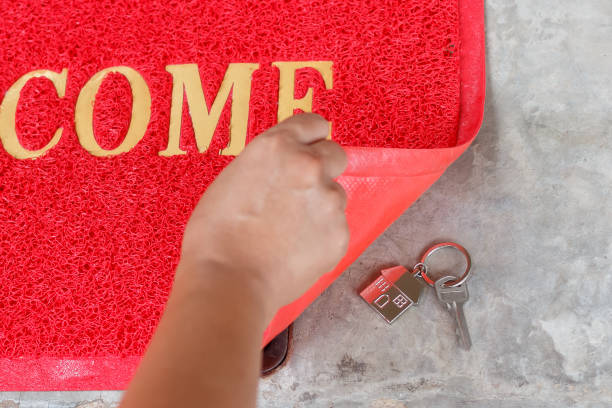By Erie Insurance, Rob Kemmer
At some point, most of us have lost our keys.
More than a few of us have even tried to break into our own property before finally admitting defeat and seeking third-party assistance.
Once we’ve been freed from our accidental exile, we waste little time before paying a visit to a local locksmith or hardware store to safeguard ourselves from future lockouts: we get a spare key.
But making a spare key is just the beginning. The more difficult task is choosing a hiding spot – one that’s both safe and easy to access in a time of need.
To help you prevent future lockouts (and future break-ins), here are some do’s and don’ts for hiding a spare house key.
DON’T: CHOOSE AN OBVIOUS HIDING SPOT
This aspect of home security risk assessment is easier than you may think. Just ask yourself, “If I had to break into a random house, where’s the first place I’d look for a hidden spare key?”
That’s what burglars do. And oftentimes, they’re right. Door mats, lintels, flower pots, mailboxes, that very fake looking rock sitting prominently atop a layer of fresh, wet mulch. These are all common places that people hide spare keys – so common, in fact, that it’s hardly worth concealing the key at all.
If you think about it, what other purpose is there, really, for a garden gnome if not to hide a spare key under it? Just don’t. There are better ways to deal with a spare key.
DO: USE DISTANCE TO YOU ADVANTAGE
Thieves are, by nature, opportunistic. So depriving a would-be burglar of easy access to your hidden key is a great first-step in home security.
Rather than trying to think of the most clever place you can conceal your key, consider simply moving it away from your home. By hanging your key on a nail in a tree at some distance from the house (or, even better, the dog house in your backyard), you’ll eliminate one lapse in security that could otherwise make your home an attractive target for thieves.
DON’T: KEEP A KEY IN YOUR WALLET
Keeping a spare key in your wallet may seem like a convenient option. But doing this can create a major security risk.
Why? Because wallets are as easy to lose as a set of keys (or even easier when pickpocketing is considered). And it’s difficult to imagine a worse place to keep your spare key than right next to identification documents with your home address on them.
Should your wallet fall into the wrong hands, you’ve not only given a crook your key, you’ve told them where to use it.
DO: GET CREATIVE
If you decide to keep a spare key handy, it’s best to get creative with your hiding place, but remember where you put it! Here are some ideas to consider:
- Use a lockbox. You don’t have to be a realtor to buy a lockbox from your local hardware store. Secure it somewhere on your property (preferably not right next to the door) to provide more secure access to your spare key.
- Buy a hidden lockbox.The fake rock may be played out. But that doesn’t mean there aren’t plenty of other solutions available online. Some creative hide-a-key options include everything from fake sprinkler heads to decoy bird houses.
- Ask a neighbor. If you have a next-door neighbor you can trust, ask them if they’ll hang on to a spare key in case of an emergency.
DON’T: TELL OTHERS ABOUT YOUR HIDDEN KEY
It’s never a good idea to advertise the fact that you hide a key outside your home – even if it’s someone you trust. Here’s a sobering fact: an astonishing 65% of burglaries are committed by someone who knows their victim.
If a friend or family member needs to gain access to your home, hide the key in a different place after they’ve used it. After all, you can never be too careful.
DO: USE TECHNOLOGY TO YOUR ADVANTAGE
One of the best ways to prevent a lockout is to eliminate the key altogether in favor of a numeric code. Keyless-entry door fixtures – both knobs and deadbolts – offer a high level of both security and convenience. And they cost less than you might think.
With long-lasting, all-weather batteries and programmable access codes, these devices allow you to do away with spare keys for good. They can also come with features such as smartphone connectivity, access logs and virtual guest keys.
For more information, check out our Homeowner’s Guide to Door Locks.
DO: STEP UP YOUR HOME SECURITY
In planning a burglary (most of which occur between 10 a.m. and 3 p.m.), a thief will often start by assessing which homes in a neighborhood are the easiest prey. Regardless of what sort of key concealment you opt for, you should periodically review and update the security of your home. Here are some tips to get started.
- Always lock doors and windows. This should be your first line of defense. Believe it or not, nearly one-third of all burglars enter a house undetected through an unlocked door.
- Never post your travel plans online. It may be hard to resist posting those beach selfies from your summer vacation spot. But social media posts can alert others that you’re away from home.
- Communicate with neighbors. If you see something (or someone) suspicious around your house, share your concerns with neighbors. It never hurts to have another set of eyes on your home.
- Routinely change access codes. Regularly change the codes for keyless entry systems on doors and garage doors. This can help ensure your code doesn't fall into the wrong hands.
- Use lights and alarms. Statistics show that simple and obvious deterrents – like alarm systems and outdoor lighting – can significantly reduce the chance of a break-in.
REST EASY WITH HOME INSURANCE YOU CAN TRUST.
Assure America Insurance wants you to sleep well at night, every night. For us, that means you can feel secure about your home and the things you’ve worked so hard to get. So relax, knowing we’ve got you, your home and your investment covered. Contact a local home insurance agent near you to learn more about homeowners insurance from ASSURE.



Post Your Comment